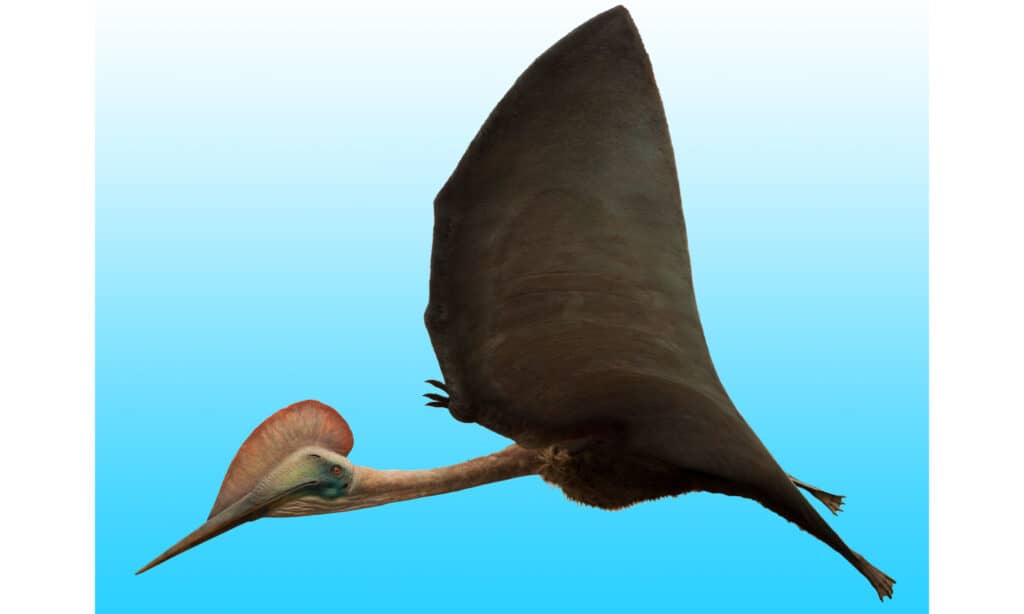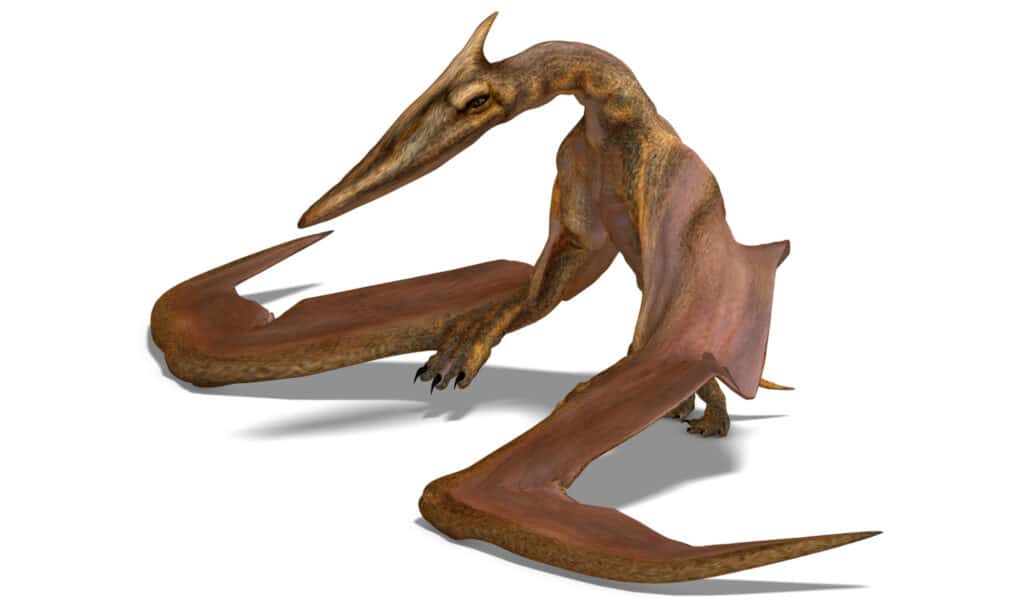The Azhdarchidae is a group of species from the order Pterosauria. “Pterosauria” literally means “winged lizard” in Greek.
Some of these dinosaurs are among the largest flying creatures known to man. Other Azhdarchidae were roughly the size of cats. Most subspecies might have reached wingspans of roughly 40 feet at maturity.
A recently-discovered Azhdarchid in Transylvania named “Dracula” had a wingspan of more than 65 feet. That’s roughly the vertical length of a six-story building! This individual would have stood at around 11 feet tall when it wasn’t flying.
Azhdarchids are most notable for their abnormally long necks and legs. In the same spirit, these Pterosaurs had particularly long beaks and skulls. Most Azhdarchids had either “blunt beaks” or “long beaks,” with the latter possessing much more slender and pointy jaws.
These dinosaurs also had what looked like spikes on the tips of their wings. This tip was an exposed finger, while three interior fingers would have tucked beneath each wing.
- The Azhdarchidae belong to the order Pterosauria.
- Pterosauria means “Winged Lizard” in Greek.
- Wingspans ranged from 2 feet up to 65 feet
- Long necks, legs, and beaks
- Exposed finger claws at ends of wings
Diet – What Did Azhdarchids Eat?
Due to their prolonged jaws and beaks, researchers long believed Azdharcidae to be “skimmers.” Skimming animals tend to glide through the air, dragging or “skimming” their lower jaws through the water to collect food.
That said, researchers estimate that these predators were more like storks than skimmers. They would have fed on small dinosaurs in most cases. There are a variety of Azhdarchids ranging in size and beak style, however, implying that there were different diets. It’s likely that were some that ate fish, crustaceans, small dinosaurs, or even large dinosaurs in the case of larger individuals.
This puts Azhdarchidae individuals into the piscivore, insectivore, carnivore, omnivore, or durogaphore categories.
It’s important to note that paleontologists and researchers aren’t in agreement about Azdharchid’s diet. There are numerous hypotheses concerning the type of foods they ate, the roles of their pointed beaks, and what those factors mean about their lifestyle.
The interesting thing about these dinosaurs is that they had numerous features (beaks, flight, skeletal structure, phalanges) that suggest conflicting things. They could potentially skim, wade, forage, scavenge, hunt, fish, and more.
The Bodies of Azhdarchids
It’s easy to see “winged lizard” and imagine what an Azhdarchid would have looked like. That said, the image that comes to mind is probably inaccurate. If you get a sense of the bodily shape of these dinosaurs, it’s easier to see why they would live inland rather than soaring overhead or floating in great bodies of water.
The giant heads, necks, and wings of Azdharchids are easy to accurately imagine. Beneath the wings, however, the skeletal system looks a lot more like a large mammal such as a giraffe.
When standing, relatively long hindlegs provided the foundation for much longer forelegs, which positioned the spine at a 45-degree angle up toward the neck. This would have been the general posture if an Azhdarchid were standing or walking. These large hindlegs and forelegs would have made it difficult for Azhdarchids to effectively maneuver while wading for food.
- Could have eaten a variety of foods
- Diet depended on the environment
- Some might have eaten large dinosaurs, fish, insects, crustaceans, and more
- There’s a dispute surrounding an Azhdarchid’s primary diet and methods of finding food

Azhdarchids like this Hatzegopteryx had long necks, legs, and beaks.
©Arctium Lappa/Shutterstock.com
Habitat – When and Where It Lived
These flying lizards existed mostly from the Mesozoic Era to the late Cretaceous Period, spending roughly 160 million years on earth, dying out around 66 million years ago. These toothless predators were very successful adaptors as well. Azhdarchid pterosaurs are discovered around the world.
Taphonomic evidence and location of discoveries suggest that Azhdarchids spent a lot of their time inland. Fossil evidence tells us these dinosaurs likely spent time foraging for food rather than wading in water for it, although paleontologists debate this.
Their slender, padded feet would have made it hard to effectively wade. A wide-reaching wingspan and pointed beaks make foraging a lot easier, however. This is why some researchers suggest that Azhdarchids were much like storks or hornbills (generalists) who live inland, typically near rivers, streams, and lakes.
- Lived from the Mesozoic Era to the late Cretaceous Period
- 160 to 66 million years ago
- Lived all over the world
- Fossils discovered on most continents
Threats And Predators
Seeing as there is such a size variety across Azhdarchid subspecies, there’s a corresponding variety of potential threats and predators. On the high end, large Azhdarchid individuals would likely have been apex predators. They would have had no trouble from most of the dinosaurs in their environment.
On the other hand, some potential threats would have existed. Existing across the world, these dinosaurs would have lived among the likes of the largest and most famed predators in the dinosaur world. This includes the monstrous tyrannosaurs, spinosaurs, and carcharodontosaurids.
The largest Azdharchids might have competed with other dinosaurs at the top of the food chain. The smaller individuals, however, would certainly have had carnivorous threats.
For the same reason that paleontologists aren’t certain about Azhdarchid’s behavior and diet, they’re not precise about which dinosaurs would have been threats. The best estimates come from the relative size and locations of subspecies of Azhdarchid in relation to the predators that would have shared the same environment.
Discoveries and Fossils – Where It was Found
Fossil remains pop up in Kazakhstan, Jordan, Uzbekistan, Spain, Hungary, Romania, United States, Morocco, Canada, France, China, Russia, Australia, and the list goes on. 100 million years ago, it seems that there would have been a spot anywhere in the world for these predators.
The first pterosaur discovery occurred in 1784 when Cosimo Alessandro Collini reported the bones of an animal with strange arms and batlike wings. This went on to be the first specimen of Pterodactylus. This discovery served as a mystery to scientists for the next fifty years. Thankfully, more pterosaur bones presented themselves to expand and solidify understanding of the Pterosauria order.
Scientists distinguished and named Azdharchids in the early 1970s. One of the most notable and memorable discoveries was that of Quetzalcoatlus, a pterosaur found in Texas. This individual is one of the largest flying creatures known to man.
Its wingspan was estimated to be 33 feet. The discovery of Quetzalcoaltlus opened up the Azhdarchidae family to previously discovered bones that were misnamed. For example, Arambougiania, an Azhdarchid discovered in 1945, was believed to be in the philadelphiae species until compared to Quetzalcoatlus’ bones in 1975.
Interestingly, Quetzalcoatlus was named after the Aztec god, Quetzalcoatl. This god, whose name means “feathered serpent” or “precious serpent,” bears a clear resemblance to pterosaurs.

Quetzalcoaltlus had an estimated wingspan of 33 feet!
©Ralf Juergen Kraft/Shutterstock.com
Extinction – When Did It Die Out?
Azhdarchids went extinct roughly 60 million years ago at the end of the Cretaceous period, which was the final period of the Mesozoic Era. This period marked the extinction of roughly 75% of plants and animals on earth.
This sudden mass extinction is believed to be the result of a large asteroid or comet that struck the earth at that time. A thin layer of sediment in the geological record is evidence of this. Further, there’s strong evidence (timing, clay debris) that the Chicxulub crater on the Yucatan Peninsula was the asteroid responsible.
One effect of the impact was an overhanging cloud of dust, lasting for a long period of time and disrupting all climates of earth. Blocking the sun and changing the temperatures of almost everything on the ocean and land, this “impact winter” eliminated most life on earth.
This extinction event marks the end of the Cretaceous Period and harbors in the Cenozoic era (our current era).
Similar Animals to The Azhdarchids
There are a number of animals and dinosaurs similar to the Azhdarchids. Many of the dinosaurs in the order Pterosauria are notable and memorable for their roles in popular culture.
Let’s take a look at some modern and prehistoric creatures that are similar to the Azhdarchids:
- Pteranodons – Pteronadons have similar head and wing structures to Azhdarchids, and they’re memorable from their roles in shows like The Land Before Time and the Jurassic Park movies. These would have been a little smaller than individuals like Dracula, albeit very terrifying to humans.
- Pterodactylus – Pterodactylus is a very small pterosaur, and one of the first to be described in the Order. These would have been the size of mid-sized birds like ducks or geese, extending less than one meter in both height and wingspan.
- Giraffes – Interestingly, the large Azdharchids have a similar body structure to giraffes. There’s no known relation, of course, but the posture, length, hindlegs, front legs, and neck are all things that bare a resemblance between the two animals.
- Storks – It’s believed that storks and Azhdarchids had similar feeding habits. Further, their long, pronounced beaks and necks give them a similar look when it comes to the upper body.
Learn More About Dinosaurs
- Are Dinosaurs Reptiles?
- Are Alligators Dinosaurs?
- 8 Dinosaurs With Crests
- The Largest Sea Dinosaur In History
The photo featured at the top of this post is © Warpaint/Shutterstock.com
FAQs (Frequently Asked Questions)
When did azhdarchids live?
Azhdarchids were alive 160 million years ago until around 66 million years ago. They became extinct after the asteroid impact that ended the Cretaceous Period and wiped out three-quarters of plant and animal life on the planet.
How big were azhdarchids?
Some members of the Azharchidae family were monstrous, with wingspans reaching upwards of 60 feet! Those individuals would have stood 11 feet tall with bodies similar to giraffes, only covered by giant wings.
Other individuals would have been small, reaching wingspans of only three or four feet. There were many subspecies, all of which lived in different environments and grew to different sizes.
Where are Azhdarchid bones found?
The bones of Azhdarchids have been found all over the globe. Everywhere from Australia, to North America, to Asia, to Europe. These dinosaurs were very adaptive and could live in almost any area of the earth at the time.
Could Azhdarchids fly?
This answer is more complicated than it would seem! Most Azhdarchids, especially smaller ones, would have had the ability to fly. That said, monstrous creatures like Quetzalcoatlus (33-foot wingspan) or Dracula (65-foot wingspan) might have been too large to stay in the air for very long.
Thank you for reading! Have some feedback for us? Contact the AZ Animals editorial team.






